OpenFlow协议分析
1.搭建拓扑,完成相关 IP 配置,并实现主机与主机之间的 IP 通信。用抓包软件获取控制器与交换机之间的通信数据包。
主机 IP地址
h1 192.168.0.101/24
h2 192.168.0.102/24
h3 192.168.0.103/24
h4 192.168.0.104/24
在终端输入sudo ./../mininet/examples/miniedit.py搭建拓扑
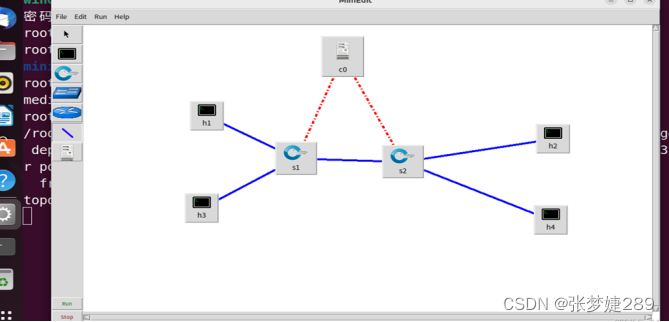
配置网段

配置IP地址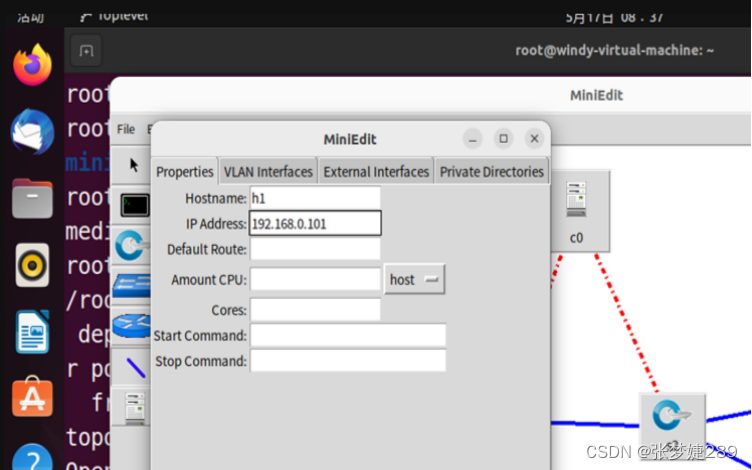
保存为Python文件
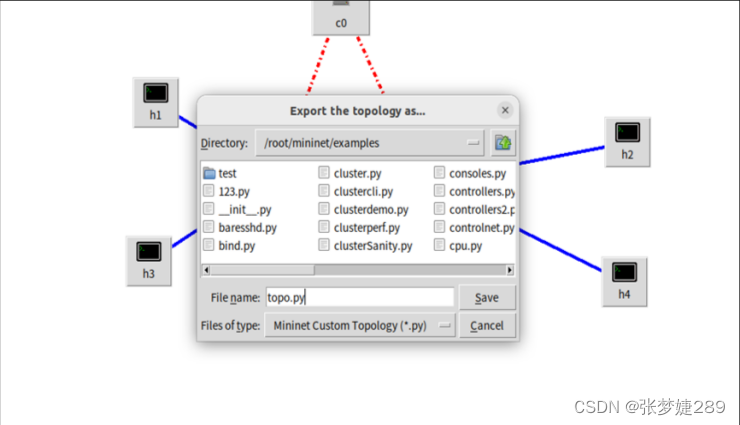
2.查看抓包结果,分析OpenFlow协议中交换机与控制器的消息交互过程,画出相关交互图或流程图。
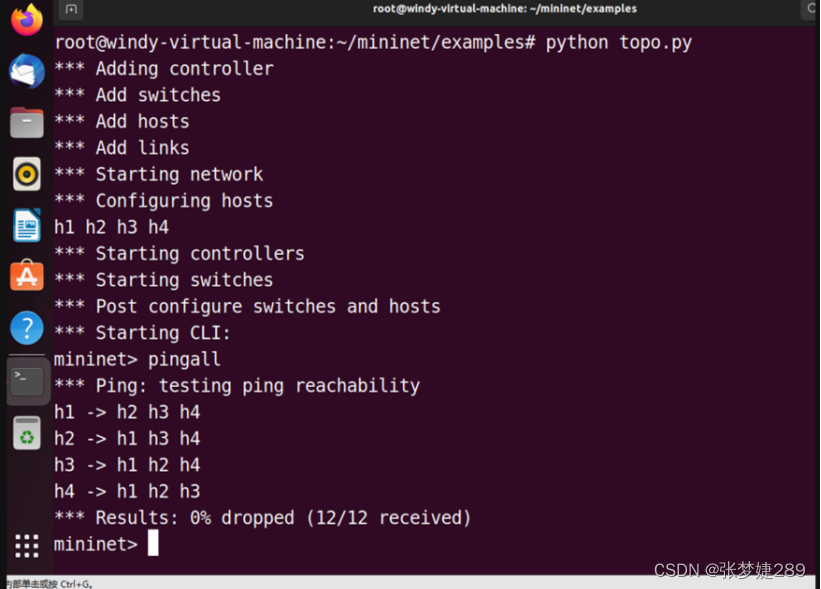
运行sudo wireshark命令,并选择any模式进行抓包,开启另一个终端,命令行运行topo.py文件,运行pingall
(1)Hello:当连接启动时交换机和控制器会发送Hello交互。
当交换机连接到控制器时,交换机与控制器会相互发送hello包,而hello消息中只包含of Header,of Header中的version字段为发送方支持的最高版本的of协议版本。如果两者协议版本兼容,则建立of连接,否则发送error消息,断开连接。交换机向控制器发送的Hello消息如下所示:
OFPT_HELLO 源端口6633 ------- 目的端口46038,从控制器到交换机

交换机46038端口(OpenFlow 1.5)-------控制器6633端口

OpenFlow交换机与OpenFlow控制器之间通过TCP三次握手过程建立连接,使用的TCP端口号为6633。
TCP连接建立后,交换机和控制器就会互相发送hello报文。Hello报文负责在交换机和控制器之间进行版本协商,该报文中OpenFlow数据头的类型值为0。
于是双方建立连接,并使用OpenFlow 1.0
(2)Features Request:控制器发向交换机的一条OpenFlow 消息,目的是为了获取交换机性能,功能以及一些系统参数。该报文中OpenFlow 数据头的类型值为5。
连接建立后,控制器向交换机发送一个features Request消息查询交换机的特性,features request消息也只包含of Header,交换机接受到该消息之后会返回一个features reply消息,这个消息就包含Header和Message。如下所示:
控制器6633端口(OpenFlow 1.0)------- 交换机46038端口
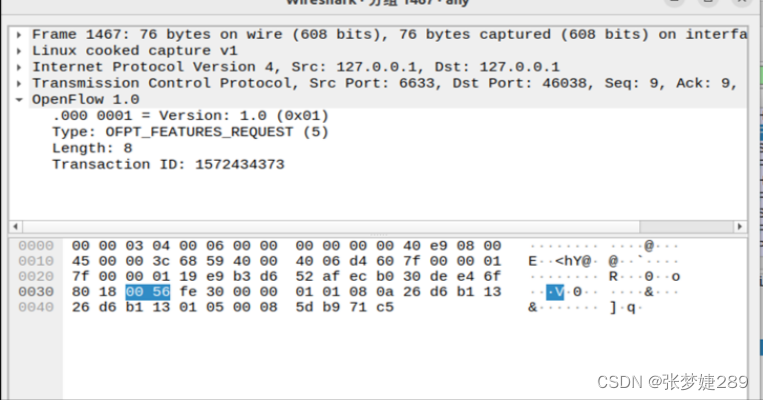
(3)Features Reply: 由交换机向控制器发送的功能响应(Feature Reply)报文,描述了OpenFlow交换机的详细细节。控制器获得交换机功能信息后,OpenFlow协议相关的特定操作就可以开始了。
交换机向控制器响应的OFPT_FEATURES_REPLY消息。如下所示
交换机46038端口(openflow 1.0)--- 控制器6633端口
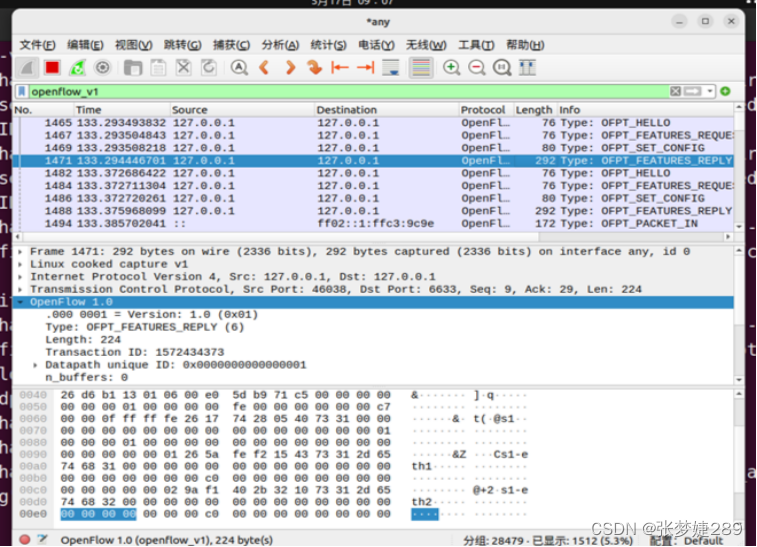
reply消息分析:
[0:8]为header(version、type、length、xid)
[8:32]长度24byte为sw的features,包含如下:
datapath_id:交换机的标识符,低48位是一个MAC地址,高16位是自定义的。
n_buffers:一次最多缓存的数据包数量。
n_tables:表示交换机支持的流表数量。每个流表可以设置不同的通配符和不同数量的流表项。控制器和交换机第一次通信的时候,控制器会从feature_reply消息中找出交换机支持多少流表,如果控制器还想了解大小、类型和流表查询的顺序,就发送一个ofpst_table stats请求,交换机必须按照数据包遍历流表的顺序把这些流表回复给控制器,并且精确匹配流表排在通配流表前。
auxiliary_id:标识辅助连接。
capabilities:所支持的功能。交换机的一些详细信息。
reserved:保留字段。
(4)Packet_in
Packet-in事件在以下两种情况下会被触发:
1.当交换机收到一个数据包后,并未与流表中匹配成功,那么交换机就会将数据封装在Packer-in消息中,发送给控制器处理。此时数据包会被缓存在交换机中等待处理。
2.交换机流表所指示的action列表中包含转发给控制器的动作(Output=Controller),此时数据不会被缓存在控制器中。
交换机向控制器递交OFPT_PACKET_IN消息。如下所示
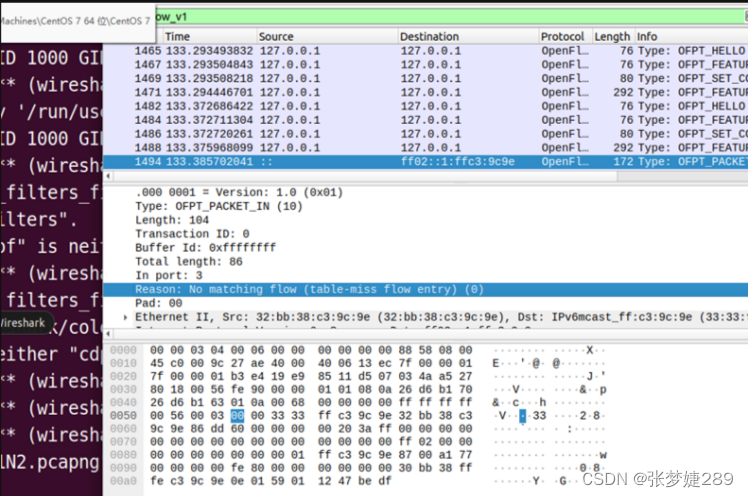
分析抓取的数据包,可以发现是因为交换机发现此时自己并没有匹配的流表(Reason: No matching flow (table-miss flow entry) (0)),所以要问控制器如何处理
(5)Flow_mod
Flow-Mod消息用于添加、删除、修改openflow交换机的流表项信息;Flow-Mod消息共有5种类型:ADD、DEKETE、DELETE-STRICT、MODIFY、MODIFY_STRICT。
ADD类型消息用来添加一条新的流表项(flow entry)
DELETE类型消息用来删除所有符合一定条件的流表项
DELETE‐STRICT类型消息用来删除某一条指定的流表项
MODIFY类型消息用来修改所有符合一定条件的流表项
MODIFY‐STRICT类型息用来修改某一条指定的流表项
分析抓取的flow_mod数据包,控制器通过6633端口向交换机46038端口、交换机46038端口下发流表项,指导数据的转发处理。如下所示

(6)Packet_out
Packet-out消息的应用场景:
指定某一个数据包的处理方法
让交换机产生一个数据包并按照action流表处理。
典型应用:链路发现
控制器向一个交换机发送packet-out消息,buffer_id=-1,data段为某种特殊数据包,actions为从交换机的某个端口进行转发,如果发出这个数据包的端口另一端也连接一个openflow交换机,对端的交换机会产生一个packet-in消息将这个特殊的数据包包上交给控制器,从而控制器他侧到一条链路的存在(控制器实现链路发现,就是依靠packet-out消息)。
当控制器断电或者交换机与控制器之间的连接断开,则交换机会寻找备用控制器,当无法找到备用控制器时便会进入紧急模式(交换机初始化时也是在这个模式下),在紧急模式下,交换机默认将所有接受到的数据包丢弃。
控制器向交换机下发OFPT_PACKET_OUT消息。如下所示
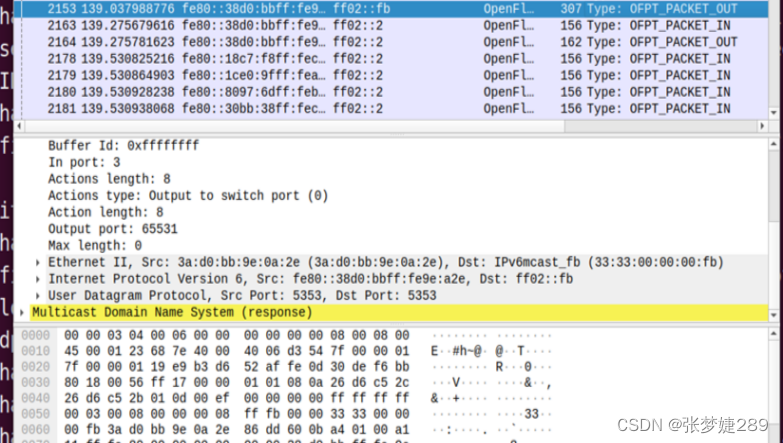
(7)port_status
当交换机端口发生变化时,告知控制器相应的端口状态。如下所示

(8)、交互图

回答问题:交换机与控制器建立通信时是使用TCP协议还是UDP协议?
分析wireshark抓包,可以看出交换器与控制器建立通信时使用的是TCP协议。
(二)进阶要求
1.将抓包结果对照OpenFlow源码,了解OpenFlow主要消息类型对应的数据结构定义。
(1)Hello
struct
ofp_header
{
uint8_t
version;
/* OFP_VERSION. */
uint8_t
type;
/* One of the OFPT_ constants. */
uint16_t
length;
/* Length including this ofp_header. */
uint32_t
xid;
/* Transaction id associated with this packet.
Replies use the same id as was in the request
to facilitate pairing. */
};
/* OFPT_HELLO. This message has an empty body, but implementations must
* ignore any data included in the body, to allow for future extensions. */
struct
ofp_hello
{
struct
ofp_header
header;
};

(2)Features Request
与Hello中的数据格式相同
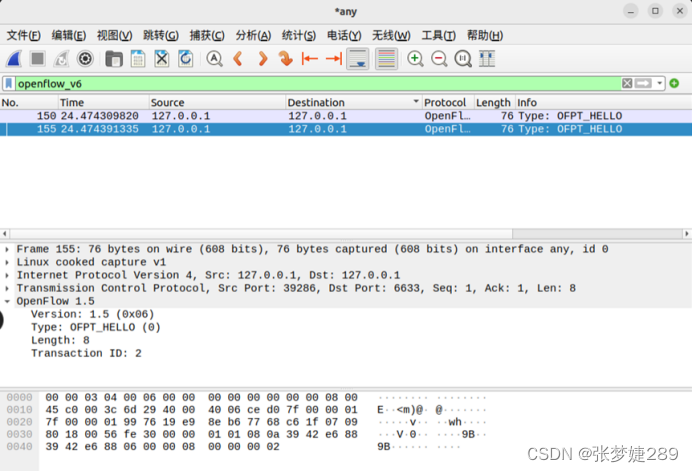
(3)Set Conig
/* Switch configuration. */
struct
ofp_switch_config
{
Struct
ofp_header
header;
uint16_t
flags;
/* OFPC_* flags. */
uint16_t
miss_send_len;
/* Max bytes of new flow that datapath should
send to the controller. */
};
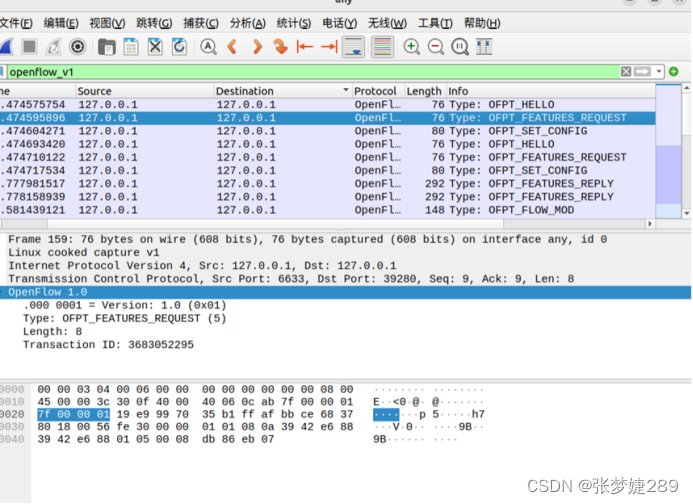
(4)Port_Status
/* A physical port has changed in the datapath */
struct
ofp_port_status
{
struct
ofp_header
header;
uint8_t
reason;
/* One of OFPPR_*. */
uint8_t
pad[
7
];
/* Align to 64-bits. */
struct
ofp_phy_port
desc;
};
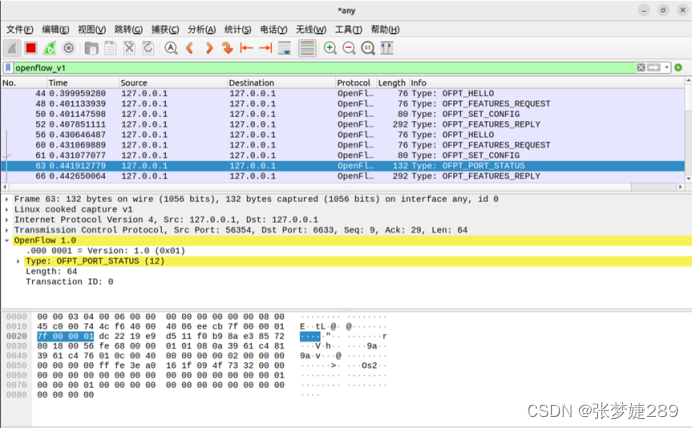
(5)Features Reply
/* Description of a physical port */
struct
ofp_phy_port
{
uint16_t
port_no;
uint8_t
hw_addr[OFP_ETH_ALEN];
char
name[OFP_MAX_PORT_NAME_LEN];
/* Null-terminated */
uint32_t
config;
/* Bitmap of OFPPC_* flags. */
uint32_t
state;
/* Bitmap of OFPPS_* flags. */
/* Bitmaps of OFPPF_* that describe features. All bits zeroed if
* unsupported or unavailable. */
uint32_t
curr;
/* Current features. */
uint32_t
advertised;
/* Features being advertised by the port. */
uint32_t
supported;
/* Features supported by the port. */
uint32_t
peer;
/* Features advertised by peer. */
};
/* Switch features. */
struct
ofp_switch_features
{
struct
ofp_header
header;
uint64_t
datapath_id;
/* Datapath unique ID. The lower 48-bits are for
a MAC address, while the upper 16-bits are
implementer-defined. */
uint32_t
n_buffers;
/* Max packets buffered at once. */
uint8_t
n_tables;
/* Number of tables supported by datapath. */
uint8_t
pad[
3
];
/* Align to 64-bits. */
/* Features. */
uint32_t
capabilities;
/* Bitmap of support "ofp_capabilities". */
uint32_t
actions;
/* Bitmap of supported "ofp_action_type"s. */
/* Port info.*/
struct
ofp_phy_port
ports[
0
];
/* Port definitions. The number of ports
is inferred from the length field in
the header. */
};
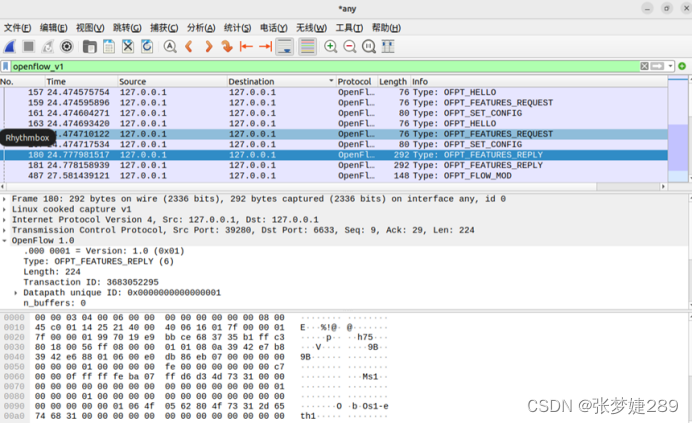
(6)Packet_in
/* Why is this packet being sent to the controller? */
enum
ofp_packet_in_reason
{
OFPR_NO_MATCH,
/* No matching flow. */
OFPR_ACTION
/* Action explicitly output to controller. */
};
/* Packet received on port (datapath -> controller). */
struct
ofp_packet_in
{
struct
ofp_header
header;
uint32_t
buffer_id;
/* ID assigned by datapath. */
uint16_t
total_len;
/* Full length of frame. */
uint16_t
in_port;
/* Port on which frame was received. */
uint8_t
reason;
/* Reason packet is being sent (one of OFPR_*) */
uint8_t
pad;
uint8_t
data[
0
];
/* Ethernet frame, halfway through 32-bit word,
so the IP header is 32-bit aligned. The
amount of data is inferred from the length
field in the header. Because of padding,
offsetof(struct ofp_packet_in, data) ==
sizeof(struct ofp_packet_in) - 2. */
};
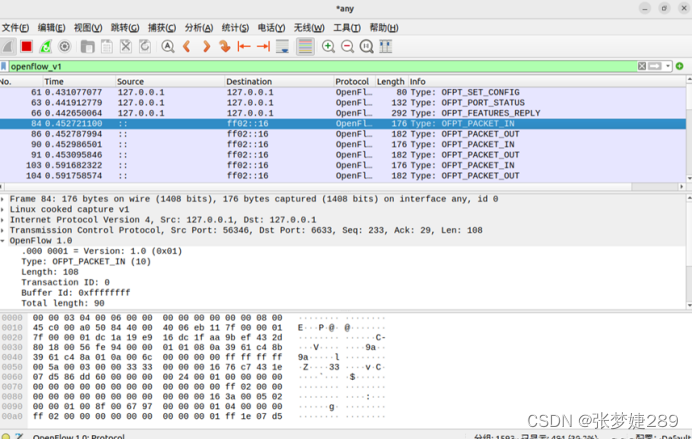
(7)Flow_mod
/* Fields to match against flows */
struct
ofp_match
{
uint32_t
wildcards;
/* Wildcard fields. */
uint16_t
in_port;
/* Input switch port. */
uint8_t
dl_src[OFP_ETH_ALEN];
/* Ethernet source address. */
uint8_t
dl_dst[OFP_ETH_ALEN];
/* Ethernet destination address. */
uint16_t
dl_vlan;
/* Input VLAN id. */
uint8_t
dl_vlan_pcp;
/* Input VLAN priority. */
uint8_t
pad1[
1
];
/* Align to 64-bits */
uint16_t
dl_type;
/* Ethernet frame type. */
uint8_t
nw_tos;
/* IP ToS (actually DSCP field, 6 bits). */
uint8_t
nw_proto;
/* IP protocol or lower 8 bits of
* ARP opcode. */
uint8_t
pad2[
2
];
/* Align to 64-bits */
uint32_t
nw_src;
/* IP source address. */
uint32_t
nw_dst;
/* IP destination address. */
uint16_t
tp_src;
/* TCP/UDP source port. */
uint16_t
tp_dst;
/* TCP/UDP destination port. */
};
/* Flow setup and teardown (controller -> datapath). */
struct
ofp_flow_mod
{
struct
ofp_header
header;
struct
ofp_match
match;
/* Fields to match */
uint64_t
cookie;
/* Opaque controller-issued identifier. */
/* Flow actions. */
uint16_t
command;
/* One of OFPFC_*. */
uint16_t
idle_timeout;
/* Idle time before discarding (seconds). */
uint16_t
hard_timeout;
/* Max time before discarding (seconds). */
uint16_t
priority;
/* Priority level of flow entry. */
uint32_t
buffer_id;
/* Buffered packet to apply to (or -1).
Not meaningful for OFPFC_DELETE*. */
uint16_t
out_port;
/* For OFPFC_DELETE* commands, require
matching entries to include this as an
output port. A value of OFPP_NONE
indicates no restriction. */
uint16_t
flags;
/* One of OFPFF_*. */
struct
ofp_action_header
actions[
0
];
/* The action length is inferred
from the length field in the
header. */
};
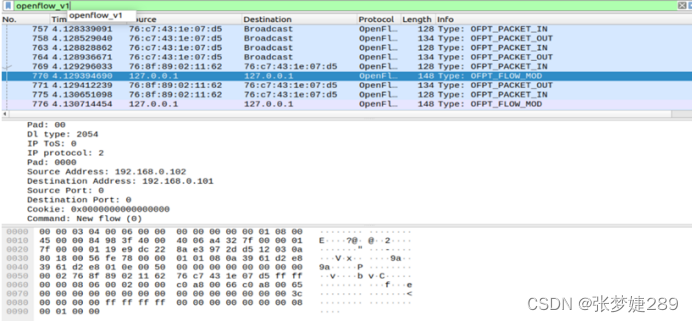
(8)Packet_out
/* Action header that is common to all actions. The length includes the
* header and any padding used to make the action 64-bit aligned.
* NB: The length of an action *must* always be a multiple of eight. */
struct
ofp_action_header
{
uint16_t
type;
/* One of OFPAT_*. */
uint16_t
len;
/* Length of action, including this
header. This is the length of action,
including any padding to make it
64-bit aligned. */
uint8_t
pad[
4
];
};
OFP_ASSERT
sizeof
(
struct
ofp_action_header) ==
8
);
/* Send packet (controller -> datapath). */
struct
ofp_packet_out
{
struct
ofp_header
header;
uint32_t
buffer_id;
/* ID assigned by datapath (-1 if none). */
uint16_t
in_port;
/* Packet's input port (OFPP_NONE if none). */
uint16_t
actions_len;
/* Size of action array in bytes. */
struct
ofp_action_header
actions[
0
];
/* Actions. */
/* uint8_t data[0]; */
/* Packet data. The length is inferred
from the length field in the header.
(Only meaningful if buffer_id == -1.) */
};
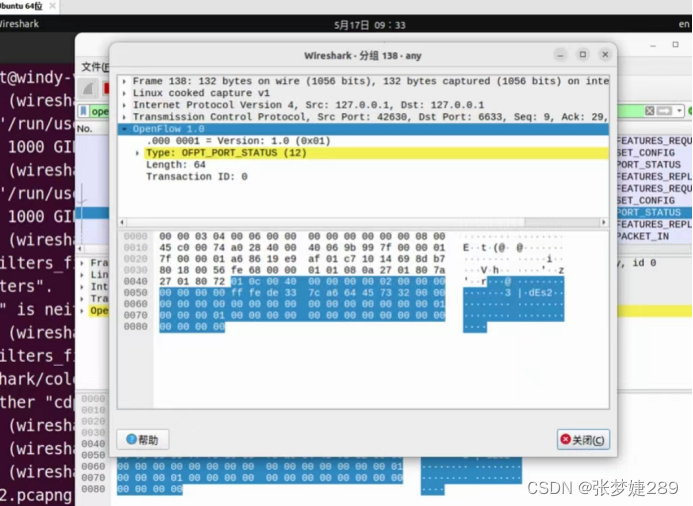
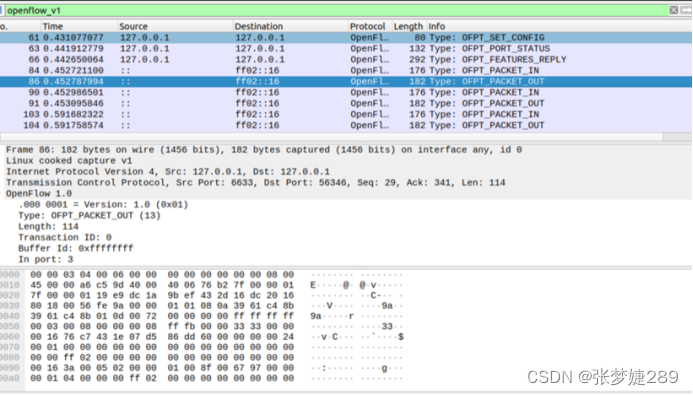
个人总结
实践成果
加深了对OpenFlow协议的理解:更加深入地理解了OpenFlow协议的基本原理和工作机制,掌握了报文的格式和字段含义。
在编写控制器应用程序的过程中,我提高了自己的网络编程能力,熟悉了SDN网络编程的基本流程和技巧。
在实验过程中,我遇到了许多问题,但通过查阅资料和不断尝试,我最终解决了这些问题,锻炼了自己的分析问题和解决问题的能力。





















 6313
6313

 被折叠的 条评论
为什么被折叠?
被折叠的 条评论
为什么被折叠?








